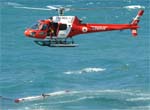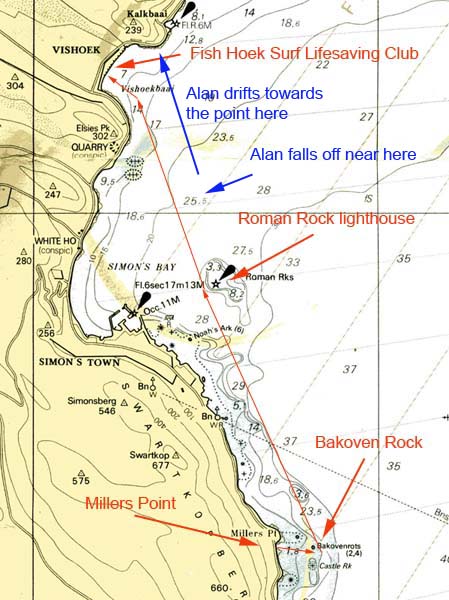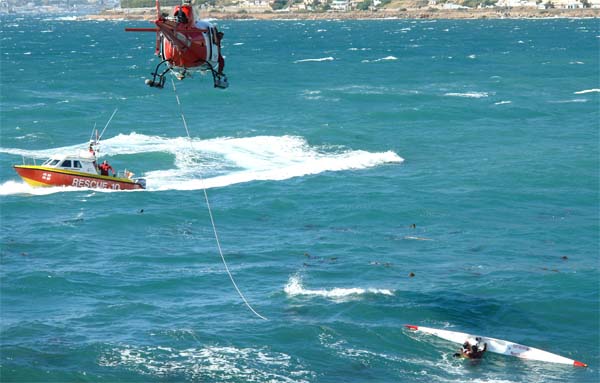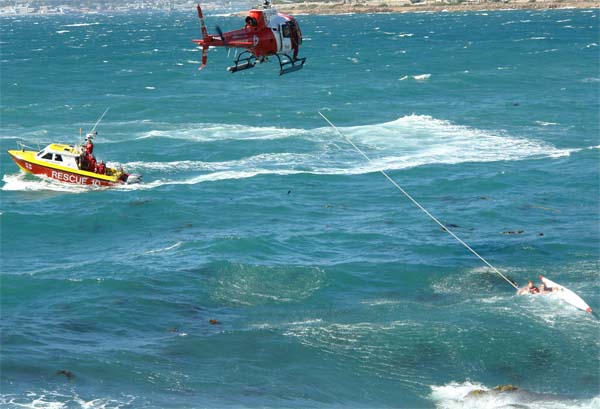Rescue in False Bay
 The Paddler
The Paddler
Christmas night 2005 - Alan Witherden lay awake listening to the howling wind. The southeaster had been blowing hard for several days and thoughts of the resulting rough seas were preying on Alan's mind. In Cape Town on holiday, he had arranged to join his friend John Rhynes for an early morning paddle the next day. They were to do the famous "Millers Run" from Millers Point near Simonstown, across the bay to Fish Hoek.
Pre-flight checks
Next morning, at the launching site, they checked their equipment. Alan was wearing a warm Helly Hanson top and PFD. He attached himself to his ski by means of a body leash rigged from a tie-down strap.
A friend, Tony Zoghby, had been tasked to keep an eye on the two paddlers - and had the NSRI number programmed into his mobile phone. If they hadn't reached Fish Hoek by 08h45 he was ready to start calling for help.
As expected, the waves were big but they were also messy, the runs spoilt by a vicious side-chop. The two men paddled conservatively until they reached the lighthouse, half way to Fish Hoek and then started attacking the waves a little more aggressively, working hard to catch the runs.
Things go pear-shaped
About half way between the lighthouse & Fish Hoek Alan came off his ski. John circled around and paddled up to Alan's ski, and held it while Alan climbed back on. Moments later, he fell off again. John held his ski again, but started to worry that he might fall off as well. When Alan fell off his ski for the third time, John told him to stay with the ski while he paddled on to Fish Hoek to fetch the Surf Lifesaving Club's rubber duck.

Alan was feeling reasonably safe - he was attached to the ski and he draped himself over it so that his body was out of the water. The only thing that kept preying on his mind was the recent documentary he'd watched on TV about Great White Sharks in False Bay...
Calling the NSRI
After a hard twenty minute paddle, John reached Fish Hoek only to find that the Surf Lifesaving Club was deserted - and the rubber duck was behind locked doors. Waiting though at the club was Tony - and the mobile phone. They called the NSRI.
Ian Klopper, the NSRI's rescue co-ordinator activated the Station 10 (Simonstown) NSRI launch as well as the standby helicopter. At the same time he alerted the nearest rescue swimmer, PJ Veldhuizen, who lives in Capri near Kommetjie. PJ ran to his car and drove to meet the helicopter at Fish Hoek. "Normally I get into a harness," he said, "but this time as I got to the chopper the pilot said there was no time - I would be in the water in a matter of seconds."
Alan had been drifting rapidly downwind for nearly forty five minutes and now he was rapidly approaching the rocks on the point between Kalk Bay and Fish Hoek. The seas were breaking heavily, but he was confident that he'd be able to scramble out with a scratch or two. The ski however was very likely going to be badly damaged.
He had no idea where John was and he was also becoming increasingly concerned that he might also be in the water somewhere out at sea.
Helicopter Rescue
Suddenly the red & white helicopter appeared and within seconds PJ Veldhuizen was in the water with him. They were within 100m of the rocks, and, although the NSRI launch arrived in a welter of spray, it couldn't reach the two men.

In spite of the noise and spray from the prop-wash, Alan managed to tell PJ that John might also be in trouble out in the bay. But first, they attempted to save the ski - the helicopter had lowered a line and PJ fitted the harness around Alan. Then by means of hand signals, he communicated to the pilot that he should try to drag the ski out into deeper water where the NSRI launch was waiting. But the wind and prop-wash were too much - Alan's leash snapped and the ski was whipped away and onto the rocks.


The helicopter crew, alarmed at the news that there might be another paddler in the water, flew Alan to the nearest land, Clovelly beach, dropped him and immediately flew out to conduct a search of the bay.

Instead of walking along the beach in the full force of the wind, Alan decided to walk inland behind the dunes. He was met by a kindly resident who wrapped him in a towel and then drove him around to the Lifesaving Club.
Ambulance
When he arrived, he found that the helicopter had landed. There was an ambulance there too, with a gurney standing next to it with what looked like a body strapped to it. "That was the only moment where I felt sheer panic," Alan said. He rushed over to the ambulance crew and demanded to know who was on the gurney. "No-one!" was the reply. They had been waiting for Alan.
And then, to his huge relief, he spotted John.
Alan was feeling cold, but otherwise fine. The ambulance crew weren't having any of that, however, and insisted that he should be checked over in hospital. Apart from the danger of hypothermia, they were concerned that he might have inhaled some salt water - heightening the risk of pneumonia.
Alan was bundled into the ambulance and taken off to Constantiaberg Hospital where he was warmed up, X-rayed, and having been given a clean bill of health, discharged.
His advice for aspiring Millers Run paddlers? "If you're not totally happy with what you're about to do," he said, "don't do it! I had my doubts but suppressed them. You need to know your limitations and don't exceed them."
Although "it took a certain amount of positive attitude", Alan did another Millers Run two days later, this time in a double, and this time without swimming...
The NSRI Rescue Co-ordinator
Ian Klopper is the NSRI sea rescue co-ordinator for the Western Cape. He's the one who authorises the activation of one or more of the helicopters on rescue standby.
There are two helicopters used for rescue work, and during the summer months Vodacom sponsors one of them which performs daily two-hour patrols and rescues. During the season, there are helicopters on two-minute standby.
Ian says that paddlers have cleaned up their act in the last few years, now being more sensible and taking more precautions. Most of the flying budget is now taken up by kite surfers. "Part of the problem is that the public doesn't understand either sport," he said, "and that so-called bad weather is a call to action on the part of paddlers and kite surfers!" Often the NSRI is called by members of the public who report "parachutes falling in the water". The dispatcher knows that it's a 95% chance that the caller is referring to a kite surfer who has just done a jump into the air, but they can't take the chance and have to send a helicopter and NSRI launch to investigate.
"But," Ian said, "people should understand that we at the NSRI don't mind false alarms. Usually it just means more practice for when the call-out is genuine."
The NSRI crews like doing rescues," he added, "that's why they belong to the organisation."
In terms of safety gear, he recommends:
- A mobile phone or small marine VHF radio in an Aquapac waterproof pouch
- Pencil flares. "Pop off several flares at intervals," he said, "and keep a couple for attracting the attention of the rescue craft when it arrives."
- A space blanket. "It weighs nothing," he said, "you can wrap it around you to keep the wind off; it glints on the sea and attracts attention; it can even help sometimes with a radar search."
- Some gluco-gel sachets. "Shivering uses up energy and you need to replace it."
The country-wide emergency number is easy to remember: 082-911.
The Sea Rescue Swimmer
What does it take to be the swimmer, plunging 5-10m into the sea from a helicopter?
PJ Veldhuizen is a 34-year old lawyer who lives near Kommetjie. He's married, has two sons and a daughter. His sons think it's great that daddy flies in a helicopter; his wife is sometimes less enthusiastic.
He's the coxswain of the Kommetjie NSRI station - and that means that he's done a SAMSA accredited course "something like a skippers' certificate on steroids". The qualification involves navigation, radio, fire fighting, medical training courses and hundreds of hours at sea.
The crew of the Kommetjie station is small - and that means that they're all on duty, all the time.
And what should accident victims know, when PJ lands in the water beside them?
"Don't fight with me!"
"Please don't fight with me!" he said, "We've done this many times before. I'll tell you what I want and then you must follow instructions."
And remember," he added, "our priorities in the situation are: one, look after ourselves; two, look after the patient and three, if there's time and the situation allows it, we might look at rescuing your equipment."
What if the patient does take it into his head to "fight back"? Well, PJ also holds a karate black belt...
Costs
One of the reasons that people don't call for help is that they're afraid of the costs. And indeed, one of the helicopters that the NSRI uses costs in the region of R13,000 per hour to fly; the other costs about R6,500 per hour.
But, RESCUES DON'T COST THE VICTIM ANYTHING. The NSRI is a fully funded organisation and that includes the costs of the rescues.
So there is no reason not to call and especially to call early. A factor that often complicates rescues is that victims don't call until it's almost too late.
Be aware though, that transportation and medical costs will be billed. The moment you climb into an ambulance to go to a hospital, you're looking at costs that will be billed to you or your medical aid. But the rescue itself is not charged.

